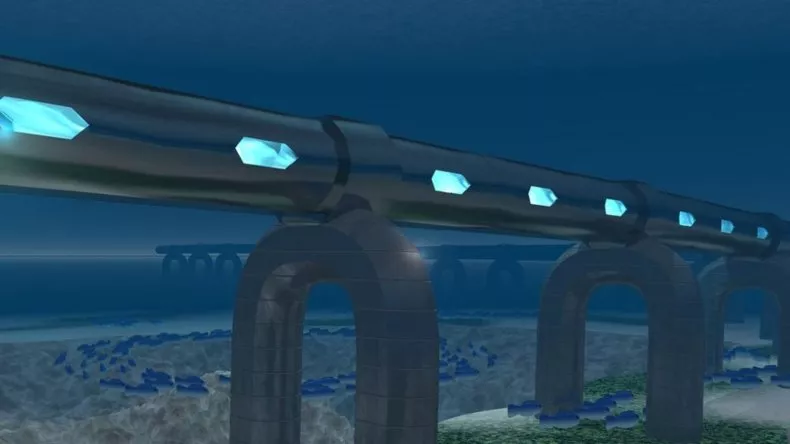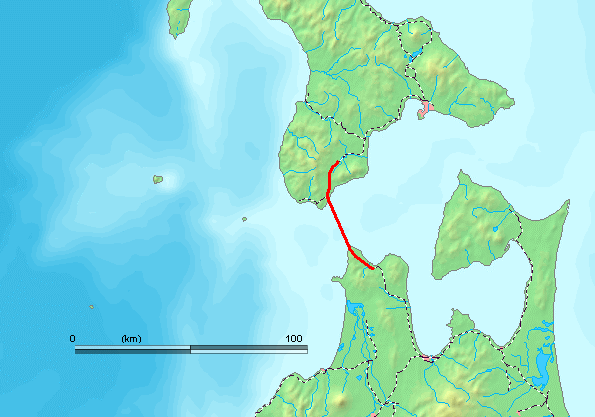The concept of a transatlantic tunnel connecting London and New York has captivated engineers and dreamers alike for decades. With a distance exceeding 3,000 miles, such a feat would dwarf any existing engineering project.
Yet, despite its appeal, the project has remained in the realm of speculation, hindered by astronomical costs, technical challenges, and questions about its practicality. However, recent advancements in vacuum tube and hyperloop technology have rekindled interest in this audacious idea.
Currently, a flight between the two cities takes approximately eight hours. While conventional trains running beneath the Atlantic Ocean would struggle to justify the massive expense, vacuum-based technology offers a tantalizing alternative.
Trains traveling through a vacuum environment would encounter no air resistance, allowing speeds of up to 3,000 miles per hour. This could cut the journey to less than an hour, transforming transatlantic travel and making the high price tag more justifiable.

The cost of constructing such a tunnel has been estimated at nearly $20 trillion, an amount equivalent to the GDP of the United States. Building on the ocean floor or using floating tunnels anchored to the seabed are among the proposed designs. While these methods are untested on such a scale, they represent potential solutions for spanning the vast expanse of the Atlantic.
Elon Musk, the billionaire entrepreneur and founder of The Boring Company, has championed vacuum tube technology. In a 2013 white paper, Musk proposed “hyperloops”—transportation systems involving capsules propelled through low-pressure tubes at hypersonic speeds.
Musk even claimed his company could complete the transatlantic tunnel for $20 billion, a fraction of the previously projected cost. Despite the bold claim, skepticism remains due to the lack of engineering plans to support such a low estimate.
The hyperloop concept has seen limited real-world testing. Virgin Hyperloop, a project backed by Richard Branson, demonstrated a 100-mile-per-hour journey in 2020.
Related Stories
In Switzerland, a pod recently traveled nearly 12 kilometers, albeit at a modest 25 miles per hour. Countries such as India and Mexico have explored integrating hyperloop systems into their transportation networks, but widespread adoption remains distant.
Historically, large-scale tunnel projects have required immense time and resources. The Channel Tunnel, connecting the U.K. and France, took six years to complete its 31-mile stretch. Scaling such an effort to traverse the Atlantic would demand revolutionary advancements in construction techniques. If built at the same pace as the Channel Tunnel, a transatlantic tunnel could take over 700 years to complete.
The scientific principles behind vacuum trains offer significant promise. By eliminating air resistance, these trains could achieve unparalleled speeds. Engineers point to the energy efficiency and environmental benefits of the technology. Unlike planes, which emit substantial greenhouse gases, vacuum trains could run on renewable energy, making them a greener alternative for long-distance travel.
Despite its potential, the tunnel faces numerous hurdles. Regulatory and financial challenges loom large. Integrating a vacuum train into existing infrastructure is another formidable obstacle.

Critics, including experts cited in The New York Times, argue that hyperloop systems might not be feasible due to the political and economic complexities involved. Some industry observers believe the concept could remain a futuristic vision rather than a tangible reality.
The transatlantic tunnel would be the longest in the world by over 3,000 miles, shattering the record held by the Channel Tunnel. Its construction would represent an unprecedented engineering achievement. Yet, until the challenges of funding, integration, and international cooperation are addressed, the tunnel remains a speculative dream.
Proponents of hyperloop technology, including Musk, argue that innovation often begins with ambitious goals. Whether the transatlantic tunnel ever materializes or not, the exploration of such ideas pushes the boundaries of engineering and transportation.
As Musk himself has stated, “The @boringcompany could do it for 1,000 times less money,” hinting at a future where bold visions might eventually align with economic realities.

While the tunnel may not yet be under construction, its potential to redefine travel and connectivity keeps the conversation alive. By advancing technologies like hyperloops and vacuum trains, humanity edges closer to making the impossible possible.
Beijing to Kunming, China: Covering approximately 2,653 kilometers, this route connects Beijing with Kunming, offering travel times between 10 hours 43 minutes and 14 hours 54 minutes.
Beijing to Guangzhou, China: Spanning about 2,298 kilometers, this line links Beijing to Guangzhou, significantly reducing travel time compared to conventional trains.

Shanghai to Kunming, China: This route extends over 2,066 kilometers, connecting Shanghai with Kunming, facilitating efficient travel across eastern and southwestern China.
Beijing to Shanghai, China: At approximately 1,318 kilometers, this line connects two of China’s major cities, Beijing and Shanghai, and is noted as the world’s longest high-speed line constructed in a single phase.
Hangzhou to Shenzhen, China: This route covers around 1,495 kilometers, linking Hangzhou with Shenzhen, enhancing connectivity along China’s southeastern coast.
Qingdao to Yinchuan, China: Spanning about 1,762 kilometers, this line connects Qingdao to Yinchuan, facilitating travel between eastern and northwestern China.

Beijing to Harbin, China: This route extends over approximately 1,700 kilometers, linking Beijing with Harbin, serving as a vital connection to northeastern China.
Guangzhou to Kunming, China: Covering about 1,285 kilometers, this line connects Guangzhou with Kunming, enhancing travel between southern and southwestern China.
Tokyo to Hakata, Japan: This route spans approximately 1,174 kilometers, connecting Tokyo with Hakata, and is part of Japan’s renowned Shinkansen network.
Madrid to Barcelona, Spain: Covering about 621 kilometers, this line links Madrid with Barcelona, significantly reducing travel time between Spain’s two largest cities.

The Seikan Tunnel in Japan is the world’s current longest undersea tunnel used by bullet trains. Spanning 53.85 kilometers (33.46 miles), it includes a 23.3-kilometer (14.5-mile) section beneath the Tsugaru Strait, connecting Honshu and Hokkaido. Shinkansen bullet trains traverse this tunnel, which descends approximately 100 meters (330 feet) below the seabed and 240 meters (790 feet) below sea level.
These high-speed rail routes exemplify advancements in rail technology, offering rapid and efficient transportation across vast distances.
Note: Materials provided above by The Brighter Side of News. Content may be edited for style and length.
Like these kind of feel good stories? Get The Brighter Side of News’ newsletter.
The post New York to London in 54 minutes: Elon Musk’s $20B vision of undersea hyperloop travel appeared first on The Brighter Side of News.